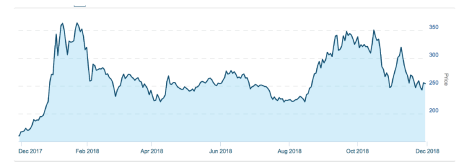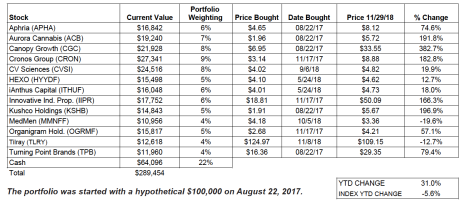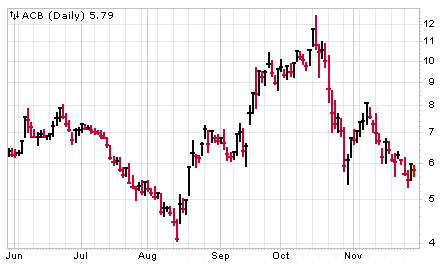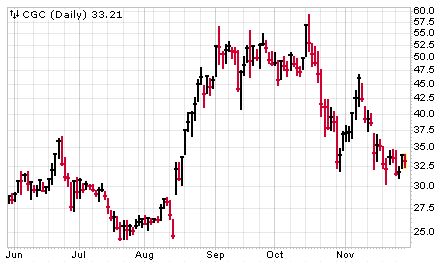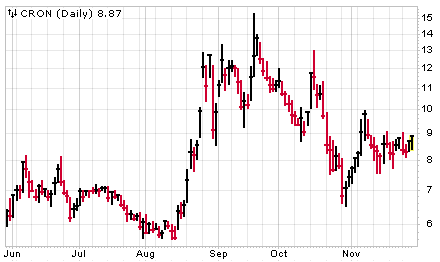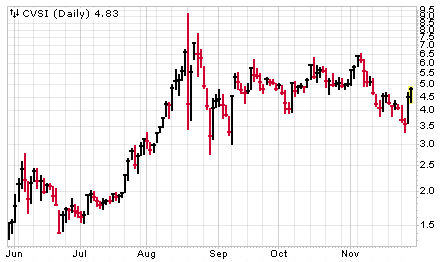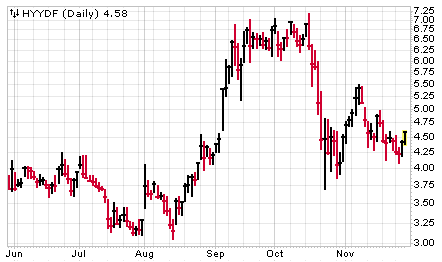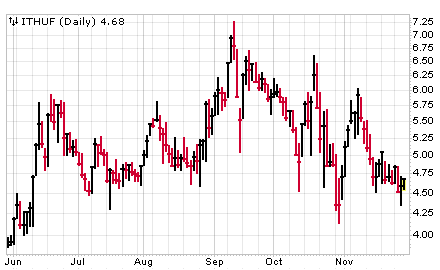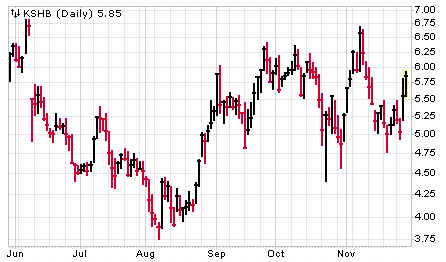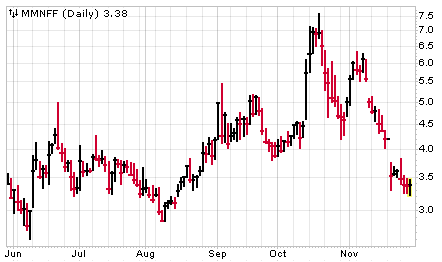In today’s issue, there are no new buy and sell recommendations, but you’ll find updates on all the stocks. And as we head toward the last of 2018, I’m very optimistic that the sector will have another great run in 2019—just when most investors least expect it!
Cabot Marijuana Investor 1118
Is the Correction Over? Part 2
The good news is that the cannabis industry in North America is booming. Legal recreational sales in Canada are very healthy, with the only problem being a supply shortage—which will be alleviated in the months ahead. And legal use continues to spread across the U.S. state by state, with Massachusetts beginning recreational sales last week and Michigan forecast to be the second-largest U.S. market once recreational sales begin there—the first heartland state to climb on the bandwagon. And just today, it appears that the House and Senate negotiators have agreed on a Farm Bill that includes Mitch McConnnell’s provision to legalize hemp—which could be very good for our CBD investments.
The industry is evolving, too. One of my favorite speakers at MJBiz.com, which I attended back before Thanksgiving, was Torsten Kuenzlen, CEO of Sundial Growers, a privately held Canadian cannabis grower. Torsten spent 17 years in management at Coca-Cola and then served as Global Chief Commercial Officer at Molson Coors, so he’s an expert in branding.
He said that while marijuana users have traditionally differentiated product by type (indica or sativa) or strain (e.g. Blue Dream or Sour Diesel), users are now learning to differentiate by effect (Energize, Alert, Create, Socialize, Relax, Sleep), and eventually, users will differentiate by brand.
Going forward as brands evolve, he projected that the price gap between low-quality product and high-quality product will widen. For example, right now mass-market marijuana might sell for $4.00 a gram, while top quality marijuana might sell for $5.00 a gram—hence the focus on reducing production costs. But he sees a future where top quality product—differentiated by scarcity and branding—sells for as much as 10 times the price of mass-market product, just as in the wine and whiskey markets!
Another speaker I liked was Sundie Seefried, who retired from a career in the credit union industry four years ago to found Safe Harbor Banking of Colorado, specifically to serve the needs of the cannabis industry in Colorado. It’s not been easy being a pioneer, and she still works extremely hard to ensure that the businesses who come to her document everything properly. But last month her bank took in $160 million in deposits, so the trend is good. And once banking is legal across the country and the tax code is fair, the industry will boom!
Last but not least, one of the speakers opined that this will be a $3 trillion industry by 2030, so with publicly traded companies currently valued at (just) $80 billion, there’s a great runway ahead for the stocks.
However—
Right now, marijuana stocks remain in a correction, along with the broad stock market, as investors flee overvalued high-risk stocks and run to the safety of low-risk dividend-payers or cash.
But there have been signs of a bottom.
For example, of the 13 stocks in our portfolio, seven remain above their October lows, working to build a bottom. And the same is true for all the broad market indexes I monitor, with the exception of the Nasdaq Composite (high-flying tech stocks have been hurt worst of all).
But as we approach the last month of the year, the odds grow that stocks that are down will stay down, as tax-loss selling and other year-end factors hold sway, so at this point, I’m inclined to sit back and wait, and listen closely the action of the stocks.
Strategy
Our strategy remains unchanged, but for my newer readers, I will repeat it. My goal is to get you invested in the companies that will be the leaders of this industry five and 10 years from now, so you amass some very big long-term profits. So the game plan is this:
1. Diversify, not just among companies but also among business models. Don’t just buy growers; buy retailers and processors and supporting players. Furthermore, when you buy, diversify by spreading out your buying over time.
2. Always be aware of your risk level. The best way to avoid big losses is to buy right. Sometimes that means starting small and averaging up over time.
3. Remember this is marathon, not a sprint. While there will be major ups and downs in the months ahead, the long-term trend for the industry is clearly up.
4. Practice short-term market timing—moderately. For example, we took profits in many stocks on October 16, the day before Canadian legalization (and the peak on the chart below), and then used some of the cash to buy back in at lower prices a few weeks later.
WHAT TO DO NOW
If you’re new to the marijuana sector, ease in slowly. Stocks you can consider now are ACB, CVSI, CGC, HYYDF, ITHUF, OGRMF and TLRY. But if you’ve already established your position, stand pat and wait for the stocks to show more strength. Never average down; only average up, over time. I’ll be watching closely to see if both the marijuana sector and the broad market can return to health in the weeks ahead.
CURRENT RECOMMENDATIONS
Aphria (APHA 8.1)
Third-largest of the Canadian growers, Aphria has been losing ground to its competitors to some extent, both fundamentally (it’s made fewer deals than its fellow large peers) and technically (its chart is weaker). But I’m not counting it out yet.
Earlier this month, Aphria announced the proposed acquisition of CC Pharma, a leading distributor of pharmaceutical products to more than 13,000 pharmacies in Germany. CC Pharma has over €200 million in annual revenue, and will be a great outlet for Aphria’s medical cannabis in Germany.
Aphria’s third quarter saw revenues grow to $13.3 million, up 117% from the same period last year. Cannabis oil sales, as a percentage of volume, increased from 29.2% to 39.1% in the quarter.
But gross margins suffered because the company was unable to fill all of the open greenhouse positions due to a lack of qualified local labor, which left it with insufficient staff to harvest its early summer crop! As a result of the lower staff levels, one week’s crop rotation outgrew its optimal harvest period, and the company chose to dispose of the affected plants to ensure the next week’s harvest was grown in optimal conditions. Subsequent to the quarter, Aphria doubled the size of the greenhouse staff, and going forward, automation is expected to solve the labor problem, as well as reduce costs. Aphria’s Canadian-based production capacity is on schedule to reach 255,000 kilograms per year.
As to the stock, we sold half on October 16 at 15.20, for a profit of 227%, and at that time I wrote, “A normal correction from here could take the stock down to 12.44 or 11.0, while a major correction could take it to 8.” But we bought back in (partially) on November 8 at 12.84 (as the sector rallied), and since then the stock has indeed fallen to my extreme downside projection of 8.
It’s tempting to say that this is a bargain-basement entry point, but in fact I don’t like the stock’s weakness. Hold.
Aurora Cannabis (ACB 5.7)
Aurora is the #2 grower in Canada, thanks in part to some big acquisitions—though in the past month the rumor that Coca-Cola was interested in doing a deal with the company has been denied. Aurora has funded production capacity of over 500,000 kg per year in Canada and Denmark. It has done lots of smaller acquisitions. It has three recognizable and well-established cannabis brands, including Aurora, CanniMed and MedReleaf, and consumer and wellness brands, such as San Rafael ‘71, Woodstock and AltaVie. And it is working hard to drive costs down.
In its fiscal first quarter, ended Sept. 30, revenues were $29.7 million, up 243% from the same period in the prior year. The number of active registered medical marijuana patients soared from 19,280 the prior year to 67,484, mainly through the integration of CanniMed’s and MedReleaf’s registered patients. The cash cost to produce a dried gram of cannabis sold fell from $1.87 a year ago to $1.45, a drop of 22%.
And since the quarter ended:
Aurora brands accounted for approximately 30% of the total market supplied through the Ontario Cannabis Store; the company’s San Rafael brand was the top selling brand in Ontario, with Aurora supplying two of the three top selling products. And the top 4 best-selling dried flower products in British Columbia were all Aurora products.
As to the stock, we sold half on October 16 at 11.56 for a profit of 490%, and at that time I wrote, “A normal correction from here could take the stock down to 9.1 or 7.5, while a major correction could take it to 6.” Well, we bought back in (partially) on November 8 at 7.71, as the sector was bouncing, but since then it’s been briefly down to 5.50 twice and now it seems to be building a base at 6. If you don’t own it, you could nibble here.
Canopy Growth (CGC 34)
With a market valuation of $11 billion, Canopy remains the undisputed king of the cannabis industry, not least because of the $4 billion contribution of Constellation Brands (STZ), whose investment kicked off the August blastoff for all stocks in the industry.
In the past month Canopy has announced the acquisition of Evergreen, Colorado-based ebbu, which uses patented plant genetics to maximize cannabinoid output by “boosting in-plant cannabinoid production and creating rare-cannabinoid-specific plants.” Ebbu’s intellectual property will be used to enhance Canopy Growth’s cannabis genetic breeding program as well as its cannabis-infused beverage capabilities.
The company has also announced a multi-year agreement with The Brink’s Company to provide secure logistics and cash management services for Canopy Growth’s domestic and international cannabis operations.
Fiscal second quarter results were good: Revenue was $23.3 million, up 33% from the prior year. Oils, including the Company’s Softgel capsules, accounted for 34% of revenues, up from 18% in the second quarter of 2018. Registered medical patients increased by 34% year-over-year to an industry leading 84,400. Year-to-date, the Company has sold 4,892 kilograms of product, up 27% from the year before. And the average sale price was $9.36 per gram, up 17% from the year before.
On the retail front, Canopy Growth finalized its acquisition of HIKU during the second quarter. Tokyo Smoke operates three retail cannabis stores in Winnipeg and plans to add 12 additional stores in provinces that support private retail by September 2019. And Canopy’s original Tweed retail chain now has eight locations selling cannabis across Newfoundland and Manitoba and an e-commerce presence in Manitoba and Nunavut. By September 2019, Tweed plans to add 20 additional brick and mortar shops in provinces with private retail models.
Last but not least, looking long range, the Company has continued to advance its stated objective of 5.6 million square feet of production across Canada, receiving licenses for almost 2.0 million square feet of production space.
As to the stock, we sold half our position on August 31 at 45.32 for a profit of 552%, and sold half again (of what remained) on October 16 at 55.35 for a profit of 696%. At that time I wrote, “A normal correction from here could take the stock down to 50, while a major correction could take it to 35—or even 28, almost half today’s value.” We bought back in (partially) on November 8 at 43.62. Since then the stock has bottomed in the 31 area, and it now sits at 32, riding its uptrending 200-day moving average.
Cronos Group (CRON 8.9)
Cronos is the fourth largest (by market capitalization) of the Canadian marijuana stocks, and while it doesn’t have the institutional backing of the biggest players, it still has a good story and a healthy, if volatile, chart.
Cronos has operations in Canada, Colombia, Germany, Poland, Israel and Australia. It has the capacity to grow 117,150 kilograms of marijuana per year. And it has a 50/50 strategic branding partnership with MedMen that will pay off as the MedMen brand enters Canada.
Third quarter revenues, from selling in Ontario, British Columbia, Nova Scotia and Prince Edward Island, were $3.8 million, up 186% from the year before. Kilograms sold grew 213% from the year before. And cannabis oil sales represented 29% of revenue.
Additionally, the company launched its mainstream recreational brand Spinach in the quarter. And it announced a partnership with Ginkgo Bioworks to produce cultured cannabinoids through fermentation that are identical to those extracted from the cannabis plant. The goal is to produce large volumes of eight target cannabinoids from custom yeast strains by leveraging existing fermentation infrastructure (i.e. breweries or pharmaceutical contract manufacturing operations) without incurring significant capital expenditures. It’s a creative idea.
As to the stock, we sold half our position on October 16 at 12.10 for a profit of 285%, and I wrote, “a normal correction from here could take the stock down to 9.8 or 8, while a major correction could take it to 7.2.” We then bought back (partially) on November 8 at 9.20, as the sector rebounded. Since then the stock has been as low as 6.5, overshooting my target a bit (a sign of thin trading), but has rebounded well and is currently settling into a base around 8.50, well above its 200-day moving average.
CV Sciences (CVSI 4.8)
CV Sciences is not in the marijuana business; instead it’s the number one seller of cannabidiol (CBD) oil, which is sold across the U.S. in health food stores, marijuana dispensaries and online under the brand Plus +CBD. And most CBD oil comes from hemp, a cousin of marijuana.
In the third quarter, the company saw revenues of $13.6 million, up 143% from the year before, and EBITDA (a measure of cash flow) of $4.1 million, up from $3.3 million the year before.
In the quarter, the company grew its retail channel distribution to 2,093 stores, up 6% from the second quarter. It achieved the industry’s first hemp extract self-affirmed Generally Recognized as Safe (GRAS) status for its hemp-derived CBD gold extract product line. It launched a new category of PlusCBD Oil Gummies. And it reported continued progress in its Drug Development Division, including preclinical progress with CVSI-007, the company’s patent-pending synthetic-based cannabidiol, which will be co-administered with nicotine to provide treatment options for smokeless tobacco use and addiction, currently a multibillion-dollar market with no currently FDA-approved drugs available to help patients.
As to the stock, CVSI avoided the big selloff of the marijuana growers post-legalization (diversification can be comforting) but it had weakened in November until yesterday, when the stock surged 27%. It was a strong day for the market as a whole, but I wonder if someone had early intelligence about the Farm Bill working its way through Congress?
HEXO Corp. (HYYDF 4.6)
Previously known as Hydropothecary, HEXO is the second-tier Canadian marijuana grower that has partnered with Molson Coors to put cannabis drinks on shelves in Canada as soon as they’re legal—probably in 2019. (Molson Coors has control of the partnership with 57.5% ownership.) It also has a partnership with the Greek company Qannabos and plans to establish a Eurozone processing, production and distribution center in Greece.
In the fiscal fourth quarter, ended July 31, revenue increased 14% from the third quarter to $1.4 million, while the volume of cannabis dried grams and gram equivalents sold increased 13% to 152,288 kilograms.
Revenue per gram increased to $9.26 from $9.24 in the prior quarter while weighted average cash cost of dried inventory sold per gram was $0.90, down 60% from the same quarter in 2017. The cost has been trending down as a result of both improvements in the cultivation processes and economies of scale (though the company honestly points out that there is no universally recognized method of calculating that cost.)
As to the stock, we sold half on October 16 at 6.72 for a profit of 63.8%, and I wrote, “A normal correction from here could take the stock down to 6.0, while a major correction could take it to 4.0.” And in fact the stock did plunge rather quickly down to 3.7 (like CRON, another thinly traded stock that overshot the mark). We then bought back in (partially) on November 6 at 5.16 as the stock rallied. Since then it’s settled down rather calmly to build a base in the low 4s.
iAnthus Capital (ITHUF 4.7)
iAnthus owns and operates growers, processors and dispensaries in six U.S. states—with a strong focus on the East Coast. That makes it a multi-state, vertically integrated operator, which means it’s insulated from tough conditions in any one state, or tough conditions in any one level of the industry (a glut of supply at the wholesale level, for instance).
And by the end of January iAnthus is expected to complete the acquisition of MPX Bioceutical, which will expand the company’s footprint to 10 states (Arizona, California, Colorado, Florida, Maryland, Massachusetts, Nevada, New Mexico, New York and Vermont), with 56 retail locations and 14 cultivation/processing facilities.
As I write, iAnthus is fully operational and generating revenue in five of its six markets, with the last market, Brooklyn, expected to open by year-end 2018.
In Massachusetts, the company operates as Mayflower Medicinals, in Florida as Grow Healthy, in New York as Citiva, in Vermont as Grassroots, in Colorado as Organix, and in New Mexico as Reynold Greenleaf & Associates.
Third quarter results were released late Tuesday. Revenues were $1.1 million, up 101% from the year before, and the company has $24 million in cash.
As to the stock, in October I wrote, “A normal correction from here could take the stock down to 4.6, while a major correction could take it to 3.8.” It got to 4.2. And now it’s in the mid 4s, working to build a base above its 200-day moving average.
Innovative Industrial Properties (IIPR 50)
Innovative Industrial Properties is the black sheep in the portfolio, and that’s been a good thing in recent weeks.
That’s because it’s a real estate investment trust (REIT) dedicated to the cannabis industry—and one of the few companies in the portfolio with actual earnings. Thus, in this portfolio of young, volatile high-flyers, IIPR is a relative rock.
As of November 7, 2018, the company owned 10 properties located in Arizona, Colorado, Maryland, Massachusetts, Michigan, Minnesota, New York and Pennsylvania, totaling approximately 952,000 rentable square feet (including approximately 114,000 rentable square feet under development), which were 100% leased with a weighted-average remaining lease term of approximately 14.7 years.
On November 7, the company reported third quarter results. Revenues were $3.9 million, up more than 150% from the prior year. Net income attributable to common stockholders was $0.21 per diluted share, and adjusted funds from operations (“AFFO”)—the key cash flow metric used to measure REITs—was $0.38 per diluted share, up more than 250% from the prior year.
Also, the Company paid a quarterly dividend of $0.35 per share on October 15, representing a 40% increase over the Company’s second quarter 2018 dividend of 25 cents per share. (The current dividend yield is around 2.8%.)
As for the stock, we sold a third on August 31 at 44.28 for a profit of 127% and on October 16, I wrote. “A normal correction from here could take the stock down to 41 (not far), while a major correction could take it to 38—or even 32. Rising interest rates are a wild card here.” Well, the stock only got down to 40, and then as the flight to safety sent investors from risky stocks (like marijuana companies) to “safe” stocks (like REITS) the stock boomed.
If you don’t own it, you could wait for a retreat down toward 41, which is near the lows from October.
KushCo Holdings (KSHB 5.7)
KushCo is another component of the portfolio that’s here for diversification away from growers as much as anything. The company was originally known as Kush Bottles, and focused on providing containers for the industry, but it’s branched out substantially over the past year.
It now targets the veterinary medicine industry with its containers. It offers design and branding services to complement its containers (many of them child-proof). It offers a wide of industrial gasses to cannabis processors, so they can turn harvested product into oils and more. It recently established an office in China to gain better control of its manufacturing relationships there, and it launched a Toronto-based subsidiary to begin to tackle the Canadian market. Note: all these operations are legal nationally.
And on Monday of this week the company reported its fourth quarter results. Revenue was up 177% year-over-year to $52.1 million, and management expects revenue to grow to between $110 million and $120 million in fiscal year 2019. The cash balance was $13.5 million, compared to $900,000 the year before. And working capital was $40.2 million, compared to $3.4 million at August 31, 2017.
As for the stock, it peaked in January with the crowd, and then set a lower peak in June and a lower one still in September (unlike the growers). (On August 31, we sold half our position at 5.30 for a profit of 177%.) In October I wrote, “A normal correction could take the stock down to 5.2, while a major correction could take it to 4.0.” And it did fall briefly to 3.8. But it’s rallied since and the pattern I see now looks pretty healthy, with a base centered in the low 5s.
MedMen (MMNFF 3.4)
MedMen is the portfolio’s problem child of the moment, but I think this will pass.
The company is the biggest cannabis retailer in the U.S., with 19 properties in 12 states and licenses to eventually operate 79 cannabis facilities. (Last month it agreed to acquire PharmaCann.) But MedMen is not only a retailer; it also grows and processes marijuana, and is thus the leading multi-state, vertically integrated company in the industry today. Unlike iAnthus, which operates under different names in very state, the MedMen brand is used across the country.
But the company’s problems today stem not from branding but from funding. Earlier this month, the company was looking to raise $120 million (to fuel its store expansion), but global markets collapsed at exactly the wrong time, with the result that only $75 million was raised and dilution was greater than originally planned. So the CFO “resigned,” and the hunt is on for a new CFO.
And, quarterly results for the first quarter of fiscal 2019 will be announced after the market close today!
And (one more wild card), there is one more multi-state, vertically integrated company that I’m interested in (in addition to iAnthus) and it’s Cresco Labs, which has operations in Illinois, Pennsylvania, Ohio, Nevada and Arizona. Cresco is still privately held but has been gearing up for an IPO, which could be soon if markets cooperate—but could be delayed if the market remains weak.
As for the stock, which spiked higher in early October on news of the PharmaCann acquisition, back on Oct 16, I wrote, “It’s hard to say what a normal correction would be so soon after the spike higher. 5.8 would be the minimal correction, with 5.0 or even 4.5 possible.” Well, the confluence of bad news has served to drive the stock all the way down to 3.3—and buyers haven’t shown up yet! It’s possible the troubles could put the kibosh on the acquisition, and investors are factoring that in, but I tend to think this is just another example of the high volatility in this sector—and that the bottom will be found soon.
Organigram (OGRMF 4.2)
Based in the province of New Brunswick, OrganiGram is the smallest of my Canadian growers by market capitalization, and possibly the lowest cost producer in Canada. Partly this is due to the company’s low cost of electricity, but partly it’s due to high yields that come from a very efficient production system, with fully automated irrigation, automated potting, fully automated waste destruction and automated packaging.
With today’s news that the company is now an official marijuana supplier to the province of Saskatchewan, the company has secured cannabis distribution agreements in nine of the 10 Canadian provinces. Organigram’s brands include The Edison Cannabis Company, Trailblazer, Ankr Organics and Trailer Park Buds.
We sold half our position on October 16 at 6.15 for a profit of 130%, and I wrote, “A normal correction from here could take the stock down to 6.0, while a major correction could take it to 4.2.” The stock hit 3.8 the very next week—and then we bought back in (partially) on November 6 at 4.91. Since then, the stock has tested at 3.8 several times, putting in a nice bottom. It now sits on its uptrending 200-day moving average, and if you don’t own it yet, you could buy some here.
Tilray (TLRY 109)
Tilray was the hottest marijuana stock on the planet in September, hitting 300 at its peak, and while it’s since lost two-thirds of that value, it is still neck-and-neck with Canopy in the valuation race, and the main reason is that it seems to have a very deep pool of management talent.
Tilray is not a major Canadian grower in the mold of Canopy, but a grower/deal-maker in the medical cannabis industry, selling to medical providers in 12 countries around the world. Additionally, the company now has agreements to supply cannabis to eight Canadian provinces and territories (British Columbia, Manitoba, Nova Scotia, Ontario, Quebec, the Yukon territory, the Northwest Territories, and Prince Edward Island).
On November 13, the company released its third quarter results.
Revenue grew 85.8% to $10.0 million. Total kilogram equivalents sold increased over two-fold to 1,613 kilograms from 684 kilograms in the prior year. Average net selling price per gram was $6.21(C$7.98) compared to $7.53(C$9.34) for the three months ended September 30, 2017. The reduction in 2018 compared to 2017 was primarily due to an increase in bulk sales as a percentage of total revenue.
During the quarter, Tilray acquired Alef Biotechnology SpA for $3.9(C$5.0) million to allow Tilray to import, produce, and distribute Tilray branded medical cannabis products to Chile and to create a hub to distribute throughout Latin America.
Additionally, Tilray imported 2:100 CBD oil to the United Kingdom; Tilray received regulatory permits in Canada and Germany to export medical cannabis flower to Germany, making Tilray the first and only company to import both flower and oil medical cannabis products to the German market; Tilray received regulatory approval from the U.S. Government to import a medical cannabis study drug in capsule form for a clinical trial at the University of California San Diego Center for Medicinal Cannabis Research to examine the safety, tolerability, and efficacy of cannabis for Essential Tremor (ET); and Tilray exported CBD 100 medical cannabis, an oral solution of cannabinoid extract, from Canada to Australia to distribute to critically ill children in Australia suffering from intractable epilepsy through a compassionate access program.
As for the stock, TLRY peaked on September 19, well before the sector’s October 17 peak, and it’s been cooling off ever since. Our original buy was on November 8, and the stock is a bit lower now, but overall, this is a stable base-building pattern, and if you don’t own it, you could start nibbling here. The portfolio has an underweight position so may average up in the future.
Turning Point Brands (TPB 29)
Turning Point is the old-school smokeless tobacco company that has been expanding into the cannabis and vaping markets, primarily through acquisitions of the Zig-Zag brand and several vaping brands, including Vapor Shark, Vapor Beast and International Vapor Group.
That means it’s not only the most established company in portfolio, Turning Point also has the ability to pay a small dividend, currently yielding 0.6%. Also, the stock does not follow the trends of the big growers’ stocks, which is good for portfolio diversification.
Third quarter results were released on November 7. Net sales increased 13.6% to a record $83.3 million, while earnings per share of $0.47 rose from $0.35 a year ago.
The Smokeless Products Segment (26% of total net sales in the quarter) grew 2.1%.
The Smoking Products Segment (34% of total net sales in the quarter) grew 4.5%.
The NewGen (New Generation) Products Segment (40% of total net sales in the quarter) grew 33.1%.
One possibly troubling piece of news in the quarter was that the company’s manufacturer of V2 e-cigarettes was bought by Juul Labs, so it needed to find new manufacturer—but management said it wouldn’t be a problem.
Additionally, in recent months, I’d become a bit concerned that Turning Point was so focused on the vaping market while consumers were clearly signaling a preference for oils—often in capsule form. So I was pleased to read just this Monday that Turning Point had acquired a minority stake (20%) in Canadian American Standard Hemp Inc. “CASH”. CASH has facilities in Warwick, Rhode Island that currently produce tinctures, capsules, topical products, vape cartridges and oral sprays that contain cannabidiol isolate (“CBD”), developed through proprietary extraction technologies. Good move.
As to the stock, it had exceeded all my expectations until October, likely because investors were drawn to the “safe” NYSE stock of the sector. (In fact we sold a third of our position on August 31 at 33.79 for a profit of 1o7%.) But that trend ended in early October with a mad spike to 47, and since then the stock has been cooling off.
Back on October 16 I wrote, “A normal correction from here could take the stock down to 39 or 38, while a major correction could take it to 23.” And here we are at 21.
STOCKS ON WATCH
Curaleaf Holdings (CURLF 5.3)
Curaleaf is another multi-state retail operator. It finished the third quarter with 29 shops around the U.S. Quarterly results saw revenue grow 289% to $21.4 million from the year-earlier quarter. Sales growth was largely the result of new marijuana shops in Florida, New York and Massachusetts and the acquisition of Swell, an Arizona-based cannabis producer. Management is aiming for sales of $400 million in 2019. The stock came public on October 29 and is working to build a base in the mid 5s. It’s thinly traded.
Charlotte’s Web Holdings (CWBHF 12)
Based in Colorado, Charlotte’s Web grows hemp and makes CBD—and claims to be the world’s leading brand by market share, with more than 3,000 retail locations. Third quarter results saw revenues at $17.7 million, up 57% from the year before, and adjusted EBITDA of $5.4 million, up 23%. The stock came public in September and is working on building a bottom around 11. It’s thinly traded.
Origin House (ORHOF 6.0)
Previously known as CannaRoyalty, Origin House is California-centric platform of holdings via royalty agreements, equity interests, secured convertible debt, and licensing agreements. Third quarter results, released just yesterday, revealed revenue of $6.6 million, up 89% over Q2 2018 and 790% over Q3 2017. The stock came public in June, peaked at 8.4 in early November, and is now working to build a base around 6.
THE NEXT CABOT MARIJUANA INVESTOR WILL BE PUBLISHED December 27, 2018
Neither Cabot Wealth Network nor our employees are compensated by the companies we recommend. Sources of information are believed to be reliable, but are in no way guaranteed to be complete or without error. Recommendations, opinions or suggestions are given with the understanding that subscribers acting on the information assume all risks. © Cabot Wealth Network. Copying and/or electronic transmission of this report is a violation of U.S. copyright law. For the protection of our subscribers, if copyright laws are violated, the subscription will be terminated. To subscribe or for information on our privacy policy, call 978-745-5532, visit www.cabotwealth.com or write to support@cabotwealth.com.

